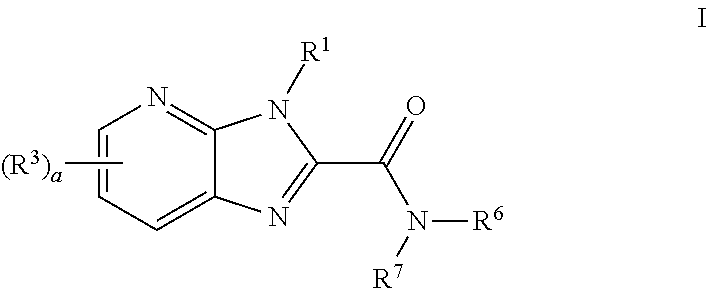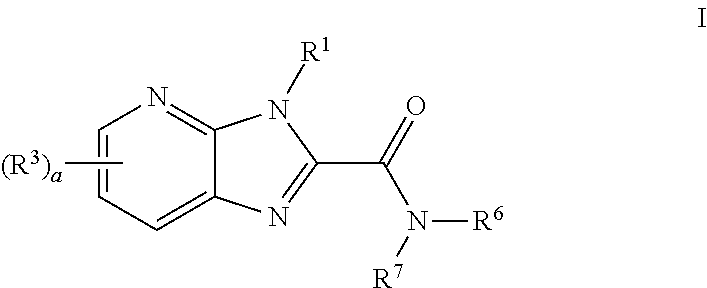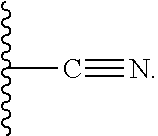Azabenzimidazole compounds
a technology of azabenzimidazole and compounds, applied in the field of azabenzimidazole compounds, can solve the problems of nausea, diarrhea, emesis, etc., and achieve the effects of reducing the risk and improving the effect of gastrointestinal side effects
- Summary
- Abstract
- Description
- Claims
- Application Information
AI Technical Summary
Benefits of technology
Problems solved by technology
Method used
Image
Examples
experimental procedures
and Working Examples
[0198]The following illustrate the synthesis of various compounds of the present invention. Additional compounds within the scope of this invention may be prepared using the methods illustrated in these Examples, either alone or in combination with techniques generally known in the art.
[0199]Experiments were generally carried out under inert atmosphere (nitrogen or argon), particularly in cases where oxygen- or moisture-sensitive reagents or intermediates were employed. Commercial solvents and reagents were generally used without further purification. Anhydrous solvents were employed where appropriate (generally Sure-Seal™ products from the Aldrich Chemical Company, Milwaukee, Wis., or solvents that had been dried and distilled using procedures familiar to those skilled in the art). Products were generally dried under vacuum before being carried on to further reactions or submitted for biological testing. Mass spectrometry data is reported from either liquid chro...
example 1
N-Cyclopropyl-3-(3-fluoro-4-methylphenyl)-3H-imidazo[4,5-b]pyridine-2-carboxamide (1)
[0205]
Step 1. Synthesis of N-(3-fluoro-4-methylphenyl)-3-nitropyridin-2-amine (C1)
[0206]A mixture of 2-chloro-3-nitropyridine (4.76 g, 30.0 mmol), 3-fluoro-4-methylaniline (3.75 g, 30.0 mmol) and potassium carbonate (8.29 g, 60.0 mmol) in dimethyl sulfoxide (30 mL) was stirred at 140° C. for 40 minutes. The reaction mixture was then cooled to room temperature, diluted with water, and extracted with ethyl acetate. The combined organic layers were washed with water, dried over magnesium sulfate, filtered, and concentrated in vacuo to afford the product as a black solid. Yield: 6.78 g, 27.4 mmol, 91%. 1H NMR (400 MHz, CDCl3) δ 10.11 (br s, 1H), 8.54 (dd, J=8.3, 1.8 Hz, 1H), 8.51 (dd, J=4.6, 1.8 Hz, 1H), 7.59-7.64 (m, 1H), 7.15-7.21 (m, 2H), 6.86 (dd, J=8.4, 4.6 Hz, 1H), 2.28 (d, J=2.0 Hz, 3H).
Step 2. Synthesis of N2-(3-fluoro-4-methylphenyl)pyridine-2,3-diamine (C2)
[0207]Zinc dust (14.3 g, 219 mmol) wa...
example 2
3-Cyclopentyl-N-cyclopropyl-3H-imidazo[4,5-b]pyridine-2-carboxamide (2)
[0210]
Step 1. Synthesis of N-cyclopentyl-3-nitropyridin-2-amine (C4)
[0211]Cyclopentanamine (2.7 g, 32 mmol) was added to a solution of 2-chloro-3-nitropyridine (5.0 g, 32 mmol) in tetrahydrofuran (200 mL), and the reaction mixture was stirred at reflux for 18 hours. After removal of solvent under reduced pressure, the residue was purified via silica gel chromatography to give the product as a yellow solid. Yield: 5.5 g, 26 mmol, 81%. 1H NMR (400 MHz, CD3OD) δ 8.42 (dd, half of ABX pattern, J=8.3, 1.8 Hz, 1H), 8.40 (dd, half of ABX pattern, J=4.5, 1.8 Hz, 1H), 6.69 (dd, J=8.3, 4.5 Hz, 1H), 4.51-4.59 (m, 1H), 2.07-2.17 (m, 2H), 1.62-1.85 (m, 4H), 1.51-1.62 (m, 2H)
Step 2. Synthesis of N2-cyclopentylpyridine-2,3-diamine (C5)
[0212]To a solution of N-cyclopentyl-3-nitropyridin-2-amine (C4) (4.7 g, 23 mmol) in methanol (100 mL) was added palladium on carbon (0.5 g), and the mixture was degassed with hydrogen. After stir...
PUM
 Login to View More
Login to View More Abstract
Description
Claims
Application Information
 Login to View More
Login to View More - R&D
- Intellectual Property
- Life Sciences
- Materials
- Tech Scout
- Unparalleled Data Quality
- Higher Quality Content
- 60% Fewer Hallucinations
Browse by: Latest US Patents, China's latest patents, Technical Efficacy Thesaurus, Application Domain, Technology Topic, Popular Technical Reports.
© 2025 PatSnap. All rights reserved.Legal|Privacy policy|Modern Slavery Act Transparency Statement|Sitemap|About US| Contact US: help@patsnap.com



